Review: the Nauticam EMWL system for bugeye photography

This review was first published in DivePhotoGuide in May 2023.
Table of contents:
- What is a bugeye lens?
- The Nauticam EMWL system
- Image quality
- Autofocus
- 160° vs 100° Objective Lenses: Which One?
- Final thoughts
Do you prefer macro or wide-angle photography? My vote goes to close focus wide angle (CFWA), a technique that produces engaging, color-rich images where the main subject appears large and detailed. These are ingredients for stunning photos, which look great on magazine covers and regularly place in competitions.
As a CFWA shooter, you always want to get closer to your subject, because you know this will amplify all the aforementioned advantages of that technique. For years, the limiting factor was the size of your dome port, with the best CFWA setups relying on 100mm mini-domes (around four inches in diameter). Then, along came the Nauticam Extended Macro Wide Lens, or EMWL, a new way of pushing through the boundaries of CFWA, with a set of “bugeye” wet lenses.
In this article, I will briefly introduce the various components that make up the EMWL, before concentrating on the two front elements that I have used extensively due to their higher bugeye potential—the 160° objective lens and the 100° objective lens. I will look at how these objective lenses differ, the variety of images you can create with them, and the limitations of the EMWL system as a whole when used with both DSLR and mirrorless cameras.

So What Is a Bugeye Lens?
A bugeye lens allows your camera to see the world from the perspective of a tiny creature—a bug, an anemonefish, a smurf—by combining a small front element, a wide field of view, and close focusing capabilities. In a nutshell, this is a tool for extreme CFWA.
For land photography, the Laowa 24mm “probe lens” is probably the most well-known bugeye option. This is the lens behind Karine Aigner’s now-famous bee mating ball photo, which won not only the 2022 Wildlife Photographer of the Year contest, but also the Big Picture 2022 grand prize.
In the underwater realm, Inon has been offering bugeye lenses for more than a decade, but these have remained niche, specialist tools. I haven’t used these myself, but I have heard that image quality and focusing challenges have gotten in the way of a broader adoption.


The Nauticam EMWL System
When fully assembled, the EMWL system attaches in front of a flat port, using a bayonet mount (via an adapter on the port’s 67mm thread). Behind the port sits your macro lens, whose narrow field of view will be converted into a much wider one by the EMWL.
The EMWL system is made up of three elements:
- the focusing unit
- the relay lens
- the objective lens
They are all “wet optics” and connect to one another via bayonet mounts, so you can assemble/disassemble them in the water.
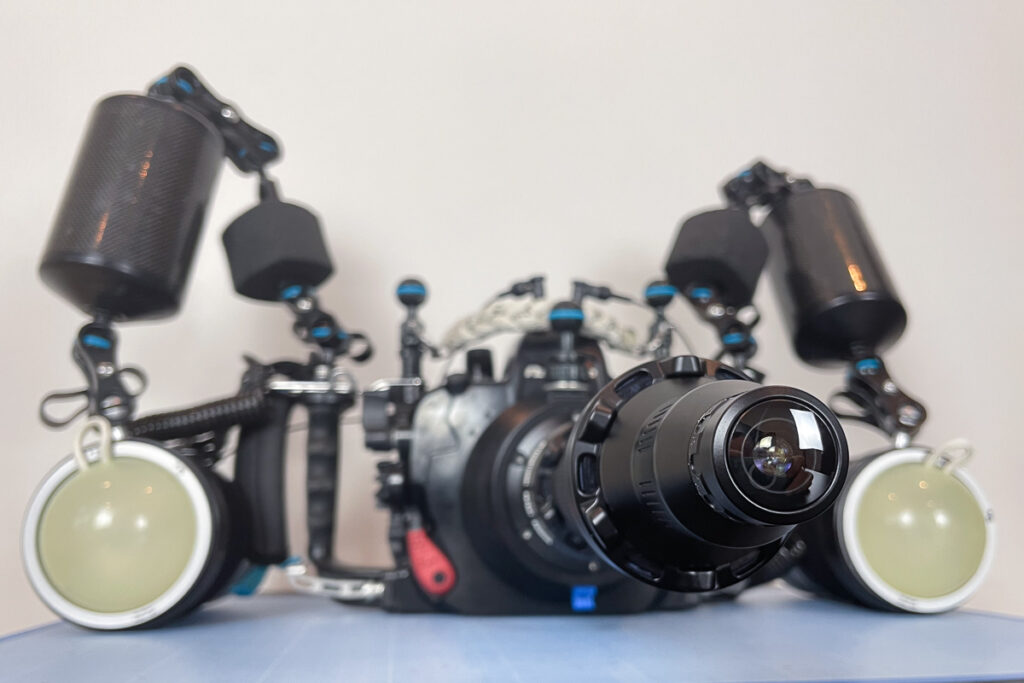
The focus unit is the base element that mounts onto the flat port. Nauticam has three versions of this focus unit covering Canon RF- and EF-mounts, Nikon F- and Z-mounts, Sony E-mount, Panasonic L-mount, Fujifilm G-mount, and the Micro Four Thirds mount. Refer to the Nauticam port chart to find out which one is suited to the macro lens that you intend on using.
The relay lens is a 150mm (6in) tube, which is installed between the focus unit and the front lens. Its role is only to invert the image: Without it, the scene will appear upside-down on a DSLR viewfinder. If you are a mirrorless user, you might be able to invert the display in your camera menus, which gives you the option of doing without this component.
Finally, there are four objective lenses to choose from, offering different fields of view, focus distances and front element diameters. My interest is creating the most extreme CFWA effect, so I am going to focus on the front optics which I feel serve that purpose best: the 100° and 160° objective lenses.

There are two reasons why the 100° and 160° objective lenses are going to produce the most extreme bugeye effect: (i) They both focus right on the front glass, and (ii) their front glass is very small—respectively, 21mm and 20mm in diameter (about 0.8in). See the 100° lens next to my son’s toy dinosaur? The toy is only 70mm tall (2.75in), but the front optic is even smaller, making the dinosaur look huge.

Before the EMWL appeared, my favorite CFWA setup was the Tokina 10–17mm fisheye zoom, producing diagonal fields of views from 100° to 180°, behind a Zen 100mm (4in) mini-dome port. The diameter of that dome is about five times larger than that of the 100° or 160° objective lens. To put it another way, with the EMWL, I can produce images that I could take with my Tokina/Zen setup if I was able to shrink the whole housing five times—while keeping my strobes at their normal size. Pretty cool, eh?

Image Quality
Considering the small size of the front element of the EMWL and the extreme expansion of the field of view, I was unsure what to expect in terms of image quality. In the following, I will detail my observations based on more than 70 hours of diving using the EMWL with my Nikon D810 DSLR, and around 17 hours with the Nikon Z9 mirrorless camera. Also, I have owned the 100° objective lens for much longer, which is why there are more images shot with the 100° rather than 160° in this review.
Light Transmission and Digital Noise
The first thing I noticed is how much light the whole system cuts down. There are multiple lenses involved in the EMWL, and once I attached it onto the flat port, my DSLR viewfinder appeared noticeably darker. With the Z9, this wasn’t noticeable, as the electronic viewfinder compensates by brightening the display.
Of course, this affects ambient light and strobe light in the same way, so I dealt with this by working at higher ISO values. Under bright daylight, I typically shot at ISO 400 or 500, and under darker conditions, I found ISO 640 to 800 to be necessary.
Using a full-frame camera is definitely an advantage here, as digital noise remains low at these moderate ISO values. With my nine-year-old 36MP D810, I was happy using the EMWL at ISO 800. With the Z9’s more modern sensor, I didn’t think twice about working at ISO 1000 or even ISO 1250 when continuous lights were involved.
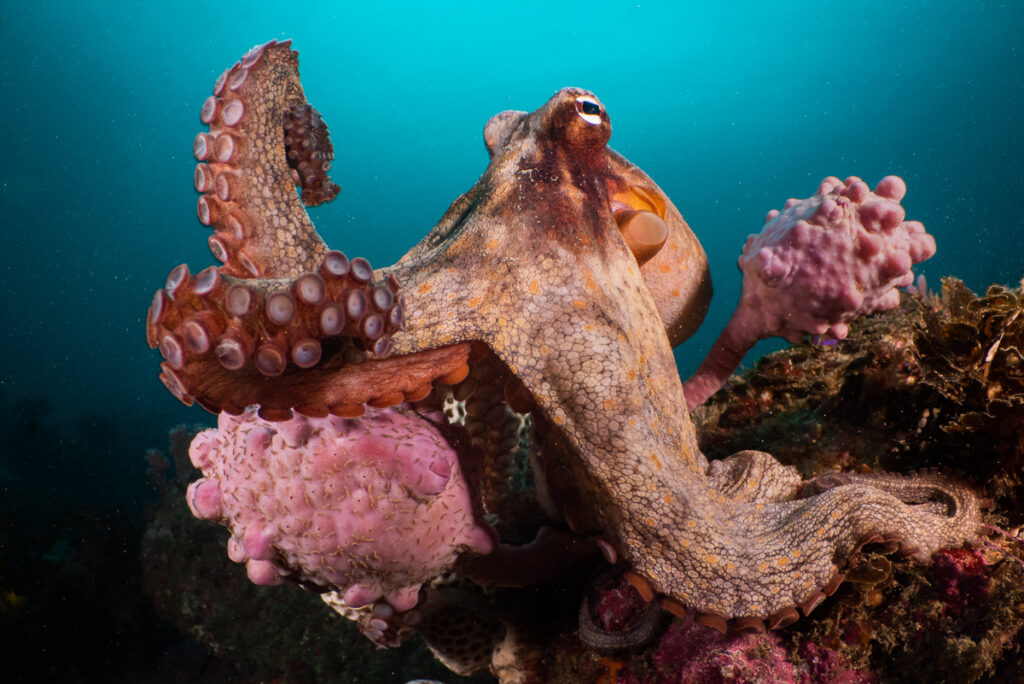

Color
Interestingly, the EMWL gives images a green-yellow color cast. This is easily fixed in post-processing with a white balance adjustment, but I’ll state the obvious: To get the best image quality out of the EMWL, you need to shoot in RAW format. I noticed the Z9’s auto white balance handles that color cast better than the D810, but still, it deserves a final touch in editing software.
When I am home and I have finished importing the RAW files into Adobe Lightroom, I take a white balance measurement, and apply it to all the photos from that last dive. Then I sit back, relax, and watch the images come to life, with vibrant and contrasty colors revealing themselves. Overall, I am very satisfied with the colors I can get out of the EMWL, especially when working close to the subject—which is what the lens is meant for.

Lens Flare
After dozens of dives with the 100° objective lens, I must say it is quite prone to flare. Under daylight conditions, be it under a jetty or in the open, whether or not the sun is in the frame, I experienced flare more often than not.
To solve this, I often attached my lens hood over the front element, but this limited how close I could get to the subject by an inch or so. In many cases, this didn’t limit my photographic opportunities, except when I found a small subject that tolerated the lens up close. In such cases, to maximize the bugeye effect, I would take off the hood and flare would return. In these instances, I resolved the issue by cutting off the ambient light completely: I increased the shutter speed until the background was black, which also masked the flare. This is why my most extreme CFWA shots taken with the 100° objective lens tend to have a black background.
By contrast, with the 160° objective lens, I didn’t notice any flare, despite using it for around 14 hours. I would need to dive that lens longer to confidently say that it never exhibits flare, but I already developed the habit of using that lens without a hood.

Sharpness
I have to confess that I am not much of a pixel peeper, so I haven’t photographed pool walls to decide if I liked the EMWL’s ability to resolve details. My qualitative opinion is that it’s excellent: When working at a close focus distance (less than a foot or 30cm), which is what this system is optimized for, I found the level of detail closer to my macro lens than to my fisheye lens.
Again, it’s a qualitative statement, but it’s worth mentioning that some of my EMWL images have won international awards, have been published in magazines, and look good when printed large, so for me, they tick all the right boxes in regards to image quality. This applies also after cropping: Not all critters let you get close enough to fill the frame, and I have cropped a number of my 36MP D810 files by as much as 33%, to 24MP. I am very satisfied with the level of detail captured even with such substantial cropping.


Depth of Field
When the subject is a foot (30cm) or further away from the front element, I found that f/11 to f/14 gave me sufficient depth of field on either of the full-frame cameras I used. As I get closer to the subject, I typically worked between f/18 and f/22 when chasing the most extreme bugeye effects.


At higher magnification ratios, when your subject nearly touches the front element, the depth of field really shrinks and the background is going to be out of focus, even at stopped-down apertures. This is a key difference with fisheye-based CFWA: At the highest magnification ratio, with the EMWL, you simply cannot get a sharp background.


Autofocus
When the EMWL was announced, the pitch was an underwater bugeye lens with “usable” autofocus. Before trying the EMWL, I was expecting the experience to be similar to using a wet diopter for super macro, meaning having to use a strong focus light to help the camera and resorting to manual focus on a regular basis.
Nikon DSLR
In 2021, the day finally came when I took the EMWL for a first dive, and I was blown away by the autofocus speed and accuracy on my Nikon D810. This was unexpected: I always considered my D810 to be slow (for a DSLR), especially when compared with my Nikon D500 and its cousin the D850.


The magic of physics and Nauticam’s clever design resulted in the vast majority of my shots being nice and sharp, with the focus exactly where I wanted it. I estimate my success rate at about 90%, and that includes swimming subjects, daylight shooting in less than 15 feet visibility (without a focus light), and night-time shooting with a red dive light. Without the EMWL, my D810/105mm combination doesn’t get anywhere close to that success rate!
I was mystified how an extra piece of glass could be improving autofocus performance, so I went to Nauticam for an explanation. In layman terms, the 105mm lens focuses faster for two reasons. First, the EMWL “compresses” the focusing distance range, meaning the lens doesn’t have to “hunt” for focus anymore. Second, the EMWL is designed to improve contrast underwater, which also helps the camera attain focus.

Nikon Mirrorless Camera
Autofocus accuracy issues have been reported when using the EMWL on some mirrorless cameras. When using the Nikon Z9 and the Z-mount 105mm lens, I have also experienced these difficulties—noticeable back-focus problems on my EMWL shots.
Without getting too technical, mirrorless cameras autofocus in different ways to DSLRs, each camera brand having its own technology. Cameras of different brands will open up the aperture to various levels to aid focusing (the more light, the easier the job), but this may result in a physical phenomenon called “focus shift,” with the risk of producing back-focused photos. Again, different camera manufacturers differ in their approach, in terms of the workarounds they use to mitigate that focus-shift problem. These workarounds are designed for specific lens constructions, and unfortunately, some of them don’t seem to hold when the optical formula is modified by adding the EMWL system into the equation.
The EMWL focus-shift situation is known to impact Nikon mirrorless cameras (which I could confirm in my testing), while Canon mirrorless bodies are essentially unaffected at the stepped-down apertures that I recommended earlier. Current Sony and Olympus mirrorless cameras appear to be unaffected too, but the issue was reported with older Sony bodies (e.g., the Sony A7R III). Fortunately, when shooting video with the EMWL on the Nikon Z9, I haven’t experienced any back-focus issue—which makes sense, as the aperture stays fixed while recording a video.
As I am writing these lines, Nauticam are conducting extensive testing to narrow down the issue and are investigating solutions to enhance the experience on affected cameras.
UPDATE October 2023: Nauticam are now offering a solution, in the form of a lens modification, visit this post for a review.
Despite the back-focus problem, I have taken some still photographs that I am very happy with using the Nikon Z9 and EMWL combination, but I had to adapt the way I shoot the system.

When autofocusing continuously (AF-C 3D), I picked a focus point sightly in front of where I wanted the focus plane to be (typically the eye). Sometimes, I had to disable animal recognition, because the Z9 would cheekily recognize the eye and try to focus on it. When the subject wasn’t moving much, I found that switching to manual focus—with focus peaking turned on—was workable, too. If you thought about using back-button autofocus, note that focus peaking will display only when you start overriding the focus manually, via the lens’ focus ring.
Overall, the experience I had when shooting the EMWL with a mirrorless camera was closer to what I was expecting initially—having to be more hands on with the autofocus. It is definitely workable, and the image quality is excellent, when following the above tips. In comparison, using the EMWL on a Nikon DSLR is ridiculously easy (I haven’t tried with a Canon body), and I hope Nauticam will find a way to raise the bar to that same level for all mirrorless shooters.

160° vs 100° Objective Lenses: Which One?
Both the 100° and 160° objective lenses are able to produce extreme CFWA images that are simply impossible to achieve with a fisheye lens, with impressive magnification ratios. Standard CFWA images are easier to produce, too, because the front element of the EMWL is less intimating than a mini-dome and housing to many marine creatures.
The 160° objective lens has become my go-to EMWL lens for day dives: It’s easy to fill the frame with a 2–4in (5–10cm) subject, and at 160 degrees, it can cover larger subjects like turtles, gropers, and sharks. Also, its wider field of view makes it much easier to include a model behind your bugeye subject. Finally, I like being able to work without flare and let ambient light brighten up my water backgrounds, even at high subject magnifications.



Despite my preference for the 160°, I still carry the 100° objective lens in a pocket and will switch as soon as the subject is a little too skittish to achieve a good magnification ratio with the 160°. Some subjects are also too small for the wider lens: The “narrow” 100° field of view gives me a more generous working distance, which also makes lighting a little easier—though, yes, we’re talking a one-inch (2–3cm) difference!
For night dives, I prefer the 100° objective lens, because I am not going to add a model in the frame, I know that flare won’t be a problem, and it will be easier to fill the frame with smaller subjects. I’ll take the 160° lens in a pocket in case a bigger animal shows up.

Final Thoughts
The EMWL system exceeded my expectations in terms of image quality and ease of use. I now always have the EMWL clipped onto a D-ring whenever I dive with my 105mm macro lens. To put it another way, when I go for a CFWA dive, I tend to pick the EMWL instead of my fisheye lens, knowing I am able to switch to macro if the need arises. This gives me a great deal of flexibility and results in more-productive dives.


About the Author
Nicolas Remy is an Australia-based pro shooter and founder of online underwater photography school The Underwater Club. His images have been widely published in print and digital media, and have won over 35 international photo awards. To see more images that Nicolas and his wife Lena have shot with the EMWL, visit their website, www.nicolaslenaremy.com, and search for “EMWL”.
Nicolas would like to thank Nauticam for supplying their NA-Z9 housing for the Nikon Z9 and the 160° objective lens for the Extended Macro Wide Lens (EMWL), and Nikon Australia for providing the Z9 mirrorless camera used in this review.

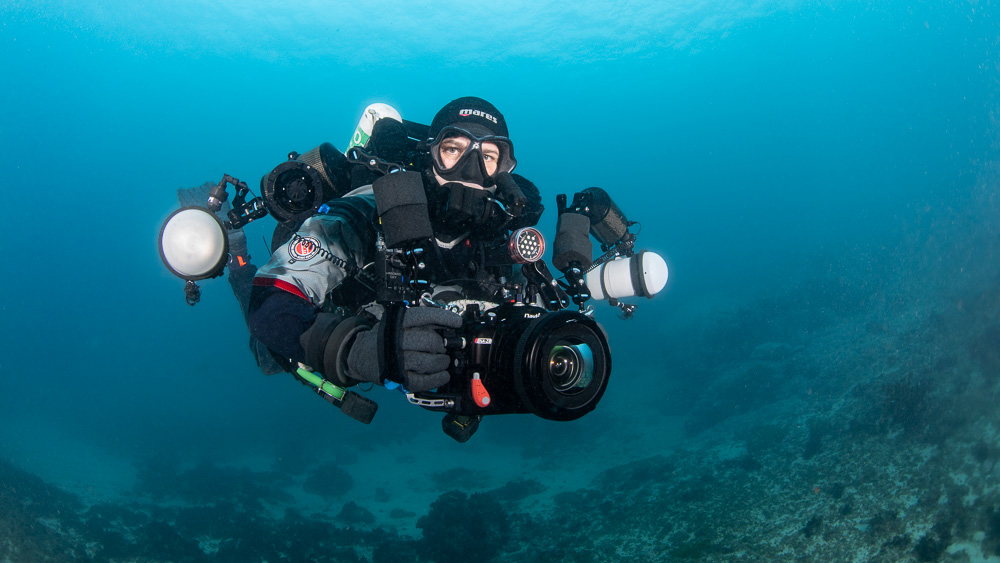
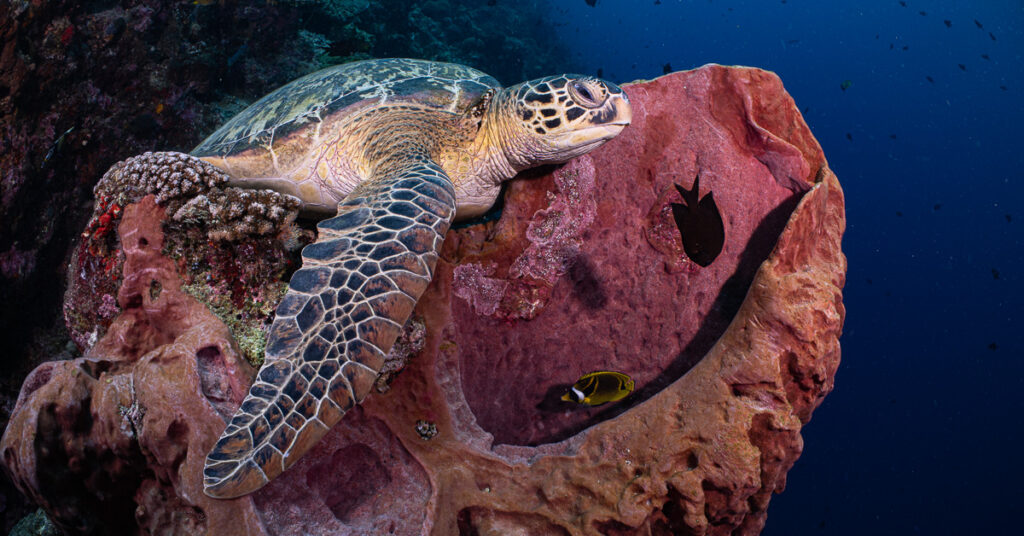

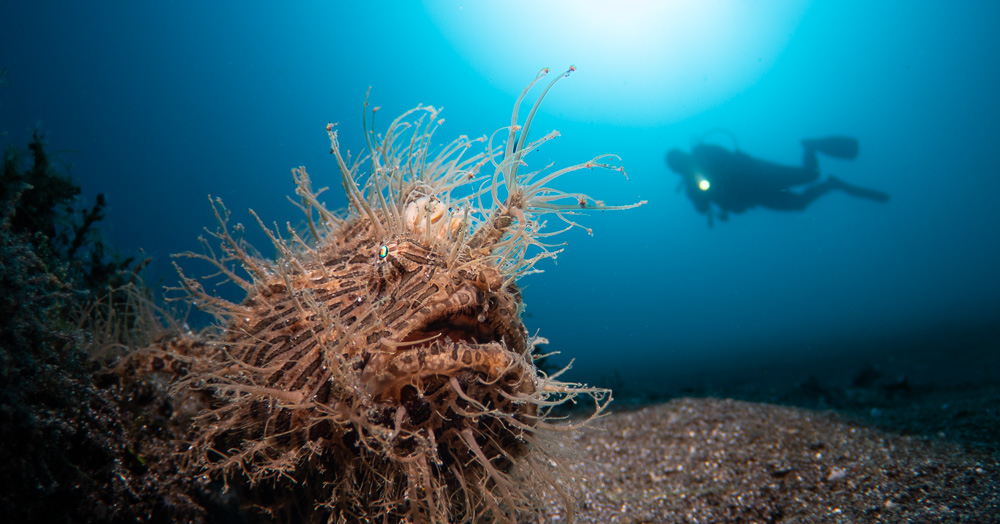
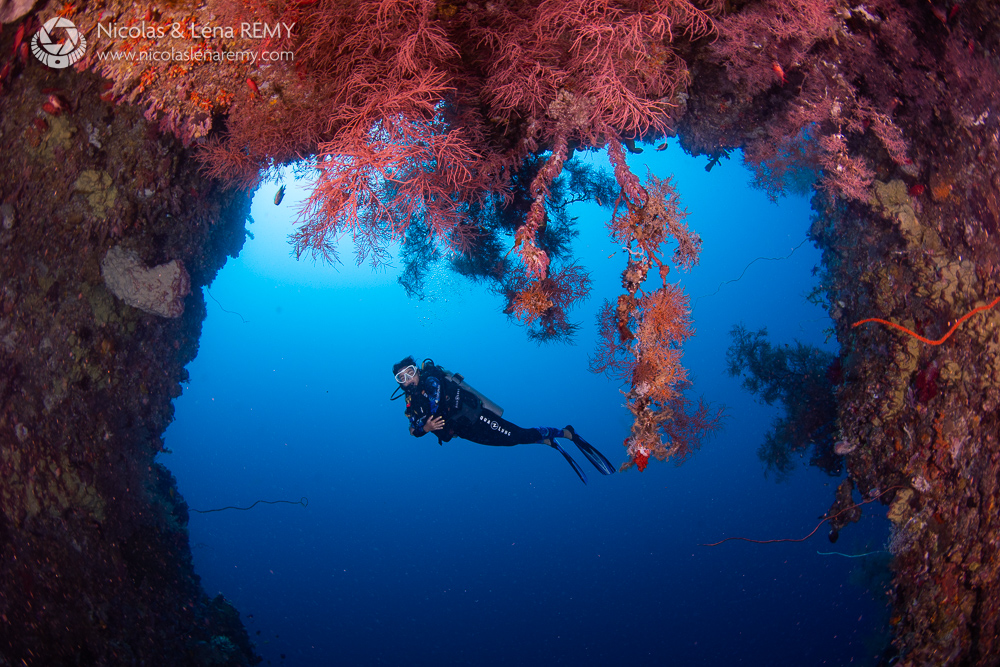
Comments